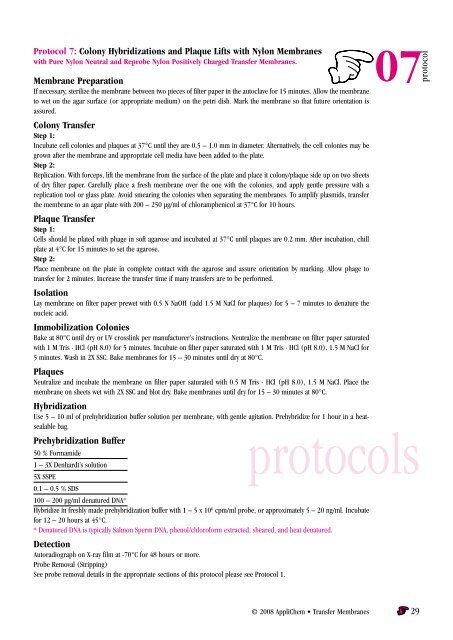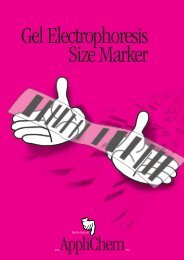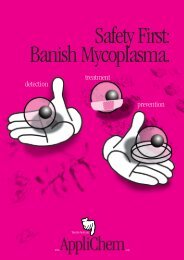Transfer Membranes
Transfer Membranes
Transfer Membranes
You also want an ePaper? Increase the reach of your titles
YUMPU automatically turns print PDFs into web optimized ePapers that Google loves.
Protocol 7: Colony Hybridizations and Plaque Lifts with Nylon <strong>Membranes</strong><br />
with Pure Nylon Neutral and Reprobe Nylon Positively Charged <strong>Transfer</strong> <strong>Membranes</strong>.<br />
Membrane Preparation<br />
If necessary, sterilize the membrane between two pieces of filter paper in the autoclave for 15 minutes. Allow the membrane<br />
to wet on the agar surface (or appropriate medium) on the petri dish. Mark the membrane so that future orientation is<br />
assured.<br />
Colony <strong>Transfer</strong><br />
Step 1:<br />
Incubate cell colonies and plaques at 37°C until they are 0.5 – 1.0 mm in diameter. Alternatively, the cell colonies may be<br />
grown after the membrane and appropriate cell media have been added to the plate.<br />
Step 2:<br />
Replication. With forceps, lift the membrane from the surface of the plate and place it colony/plaque side up on two sheets<br />
of dry filter paper. Carefully place a fresh membrane over the one with the colonies, and apply gentle pressure with a<br />
replication tool or glass plate. Avoid smearing the colonies when separating the membranes. To amplify plasmids, transfer<br />
the membrane to an agar plate with 200 – 250 µg/ml of chloramphenicol at 37°C for 10 hours.<br />
Plaque <strong>Transfer</strong><br />
Step 1:<br />
Cells should be plated with phage in soft agarose and incubated at 37°C until plaques are 0.2 mm. After incubation, chill<br />
plate at 4°C for 15 minutes to set the agarose.<br />
Step 2:<br />
Place membrane on the plate in complete contact with the agarose and assure orientation by marking. Allow phage to<br />
transfer for 2 minutes. Increase the transfer time if many transfers are to be performed.<br />
Isolation<br />
Lay membrane on filter paper prewet with 0.5 N NaOH (add 1.5 M NaCl for plaques) for 5 – 7 minutes to denature the<br />
nucleic acid.<br />
Immobilization Colonies<br />
Bake at 80°C until dry or UV crosslink per manufacturer's instructions. Neutralize the membrane on filter paper saturated<br />
with 1 M Tris · HCl (pH 8.0) for 5 minutes. Incubate on filter paper saturated with 1 M Tris · HCl (pH 8.0), 1.5 M NaCl for<br />
5 minutes. Wash in 2X SSC. Bake membranes for 15 – 30 minutes until dry at 80°C.<br />
Plaques<br />
Neutralize and incubate the membrane on filter paper saturated with 0.5 M Tris · HCl (pH 8.0), 1.5 M NaCl. Place the<br />
membrane on sheets wet with 2X SSC and blot dry. Bake membranes until dry for 15 – 30 minutes at 80°C.<br />
Hybridization<br />
Use 5 – 10 ml of prehybridization buffer solution per membrane, with gentle agitation. Prehybridize for 1 hour in a heatsealable<br />
bag.<br />
Prehybridization Buffer<br />
50 % Formamide<br />
1 – 3X Denhardt’s solution<br />
5X SSPE<br />
0.1 – 0.5 % SDS<br />
100 – 200 µg/ml denatured DNA*<br />
Hybridize in freshly made prehybridization buffer with 1 – 5 x 10 6 cpm/ml probe, or approximately 5 – 20 ng/ml. Incubate<br />
for 12 – 20 hours at 45°C.<br />
* Denatured DNA is typically Salmon Sperm DNA, phenol/chloroform extracted, sheared, and heat denatured.<br />
Detection<br />
Autoradiograph on X-ray film at -70°C for 48 hours or more.<br />
Probe Removal (Stripping)<br />
See probe removal details in the appropriate sections of this protocol please see Protocol 1.<br />
07<br />
protocols<br />
protocol<br />
© 2008 AppliChem • <strong>Transfer</strong> <strong>Membranes</strong> 29





